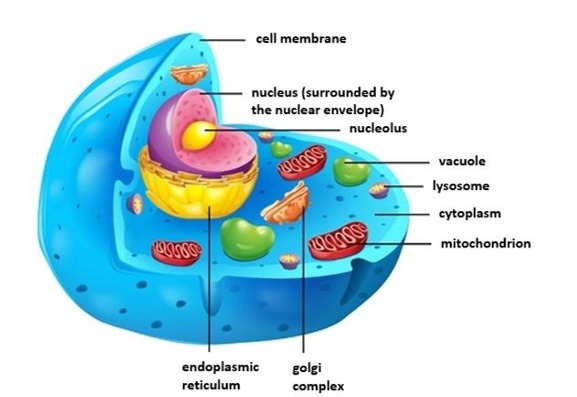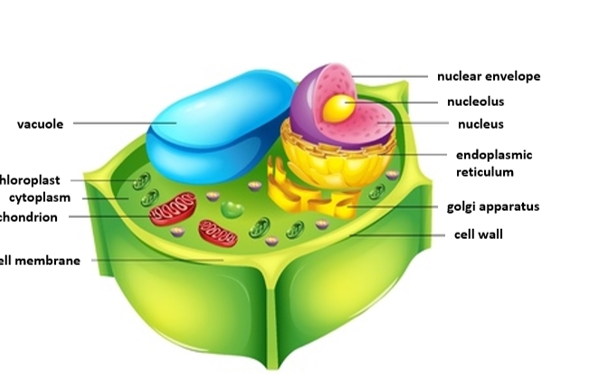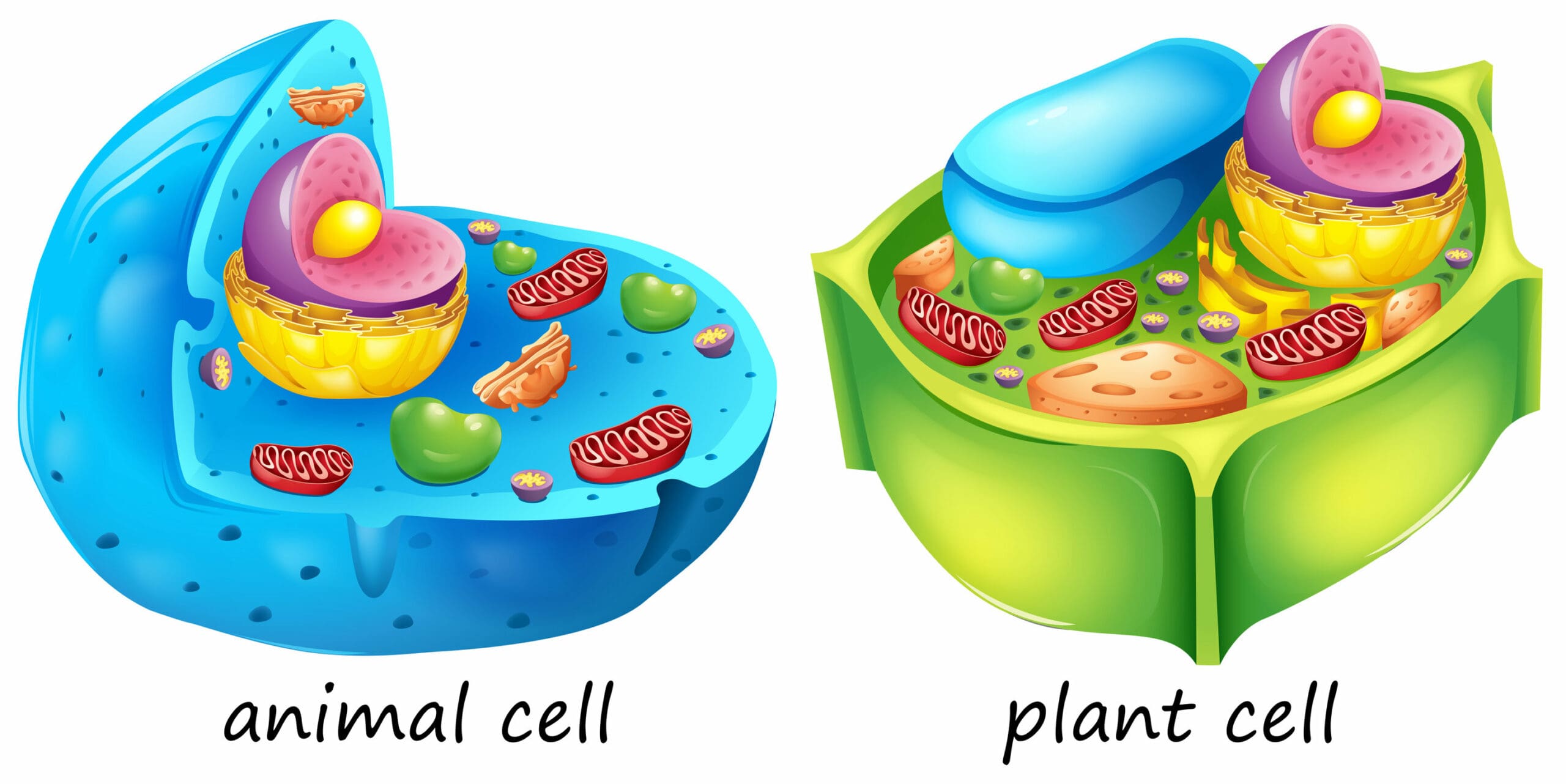As we have seen, living organisms contain common characteristics; therefore, some common characteristics can also be seen in the cells of a living organism. A cell is the smallest structural unit of all living organisms. It is usually microscopic and is fundamental for all life. A cell normally consists of one or more nuclei and other organelles enclosed within a membrane.
Most living organisms contain different types of cells. As mentioned before, humans, plants and animals are multicellular which means that they contain more than one type of cell. For example, the human body alone contains hundreds of different types of cells; we have blood cells, liver cells, nerve cells, skin cells and many more.

As you can probably tell from the above diagram, the cells in the human body have different features to help them perform different functions. This is the same with some of the other kingdoms of living organisms. In ‘Topic 1: The nature and variety of living organisms’ you may remember the general diagrams that were shown to you of the most common internal features that you will find in the cells of each living organism.
Animal and plant cells
We are now going to illustrate the structures of an animal and plant cell before discussing the main functions of the organelles within the particular type of cell. First, we will discuss a ‘typical’ animal cell.

above image illustrates the ‘typical’ structure of an animal cell (remember that not every animal cell has the same anatomy – the human body alone contains hundreds of different types of cells). Let’s look into these organelles in more detail individually.
| Feature | Definition |
|---|---|
| Cell membrane | Forms the outer covering of the cell to separate its contents from the environment. It also controls what goes in and out of the cell; meaning it is a semipermeable membrane. You can think of the cell membrane as the cell’s skin to help you remember. |
| Cytoplasm | A gel-like substance between the cell membrane and nucleus that is made up of many different structures: organelles, vesicles and various particles. The cytoplasm contains enzymes and is where many of the chemical processes take place. |
| Endoplasmic reticulum (ER) | An organelle which is a network of tubular membranes that is normally continuous with the outer nuclear membrane (the outside of the nucleus). The ER is responsible for the synthesis and modification and assists in the transport of materials into and out of the cell. |
| Golgi complex | The Golgi complex in an animal cell (also known as the Golgi apparatus) is an organelle located close to the ER. It is responsible for receiving proteins and lipids (meaning fats) from the ER and concentrating them into droplets known as vesicles. Depending on the contents of these vesicles, these are then either transported to other organelles in the cell known as lysosomes, the cell membrane or out of the cell. |
| Lysosome | An organelle that is attached to the cell membrane and varies in shape, size and number according to the particular cell it helps operate. Lysosomes contain a protein called enzymes (we will discuss this further later in the course) and are known to assist in degrading material from outside of a cell and also degrading material from inside of the cell that no longer has any significant use. |
| Mitochondrion | Mitochondrion is an organelle that is normally found in large quantities within most cells. This organelle is an essential component in the process of cell respiration. The mitochondrion therefore helps to release energy that the cell requires. |
| Nucleolus | Sits in the nucleus and contains protein and ribonucleic acid (RNA). (RNA is something we will go into detail about later in the course.) |
| Nucleus | The largest organelle found in most eukaryotic cells. It contains chromosomes (there are 46 of these in human cells) which carry the genetic material (the genes) and therefore control the activities of the cell (we will discuss more about genes later in the course). |
| Ribosomes | If you look at the animal cell diagram you will see some dark blue particles floating around in the cytoplasm. These are ribosomes. Ribosomes are sometimes found free like this or can be attached to the ER. They are where protein synthesis takes place in the cell (where protein is produced). |

Now, let’s look at the features of a ‘typical’ plant cell:

The above image illustrates the ‘typical’ structure of a plant cell. You may have already noticed the similarities between the typical plant cell above, and the typical animal cell which we looked at earlier. However, you may have also noticed some differences. The cell wall, chloroplasts and a vacuole are structures that are never found in animal cells (also notice that plant cells do not contain lysosome; this is because the same function occurs in a plant cell’s vacuole).
| Feature | Definition |
|---|---|
| Cell wall | The cell wall is found outside of the membrane of a plant cell. It is a non-living material that is made of mostly cellulose (a carbohydrate). It is a tough material that helps the cell keep its shape (unlike animal cells whose shapes tend to vary) and offers further protection. The toughness of the cell wall is essential as plant cells absorb water and in doing this they produce internal pressure which pushes against other cells to provide support. A cell wall is freely permeable as it contains large holes in it; this means that it does not constrict any materials from travelling in or out of the cell. |
| Cell membrane | The cell membrane of a plant cell works in exactly the same way as an animal cell. It is a semipermeable membrane that controls what can go into and out of the cell. |
| Chloroplasts | Chloroplasts are an essential component in the process of photosynthesis. They contain an important biomolecule known as chlorophyll. Chlorophyll is vital in the process of photosynthesis. The plant cells that make up the flowers, roots and woody stems of a plant do not contain chloroplasts and therefore do not undergo the process of photosynthesis (chloroplasts never appear in animal cells). |
| Cytoplasm | The cytoplasm of a plant cell has the exact same function as an animal cell. It is a gel-like substance between the cell membrane and nucleus that is made up of many different structures: organelles, vesicles and various particles. The cytoplasm contains enzymes and is where many of the chemical processes take place. |
| Endoplasmic reticulum (ER) | The ER is another similarity that a plant cell shares with an animal cell: it is an organelle which is a network of tubular membranes that is normally continuous with the outer nuclear membrane (the outside of the nucleus). The ER is responsible for the synthesis and modification and assists in the transport of materials into and out of the cell. |
| Golgi complex | The Golgi complex in a plant cell (also known as the Golgi apparatus) is an organelle located close to the ER. The organelle is another feature that a plant cell shares with an animal cell. It is responsible for receiving proteins and lipids from the ER and concentrating them into droplets known as vesicles. Depending on the contents of these vesicles, these are then either transported to other organelles in the cell or out of the cell entirely. |
| Mitochondrion | Mitochondrion is an organelle that is normally found in large quantities within most cells and is a similarity between animal and plant cells. This organelle is an essential component in the process of cell respiration. Mitochondria therefore help to release energy that the cell requires. |
| Nucleolus | The nucleolus sits in the nucleus and contains protein and ribonucleic acid (RNA). We will discuss RNA in detail later in the course. |
| Nucleus | The nucleus is the second largest organelle found in plant cells (the biggest is the vacuole). It contains the genetic material of the cell and therefore controls the activities of the cell (we will discuss more about genetic material and genes later in the course). |
| Ribosomes | Although not visible on the diagram provided, plant cells also contain ribosomes. Ribosomes are the places where protein synthesis occurs in the cell. Like in animal cells, ribosomes are sometimes found free in the cytoplasm of a plant cell or can be attached to the ER. |
| Vacuole | A vacuole is a permanent feature of mature plant cells. It contains cell sap (a watery liquid) which is a mixture of amino acids, mineral salts, sugars and waste substances. As well as holding materials and waste products, a vacuole provides support and structure for the growing plant as it helps to maintain pressure within the plant cell. |

The similarities and differences between animal and plant cells
There are similarities and differences between animal and plant cells; however, to highlight the similarities and differences, a table has been created for you below:
| Feature | Animal cell | Plant cell |
|---|---|---|
| Cell wall | ✗ | ✓ |
| Cell membrane | ✓ | ✓ |
| Chloroplasts | ✗ | ✓ |
| Cytoplasm | ✓ | ✓ |
| Endoplasmic reticulum (ER) | ✓ | ✓ |
| Golgi complex | ✓ | ✓ |
| Lysosomes | ✓ | ✗ |
| Mitochondrion | ✓ | ✓ |
| Nucleolus | ✓ | ✓ |
| Nucleus | ✓ | ✓ |
| One permanent vacuole | ✗ | ✓ |
| Ribosomes | ✓ | ✓ |
| Vacuoles | ✓ | ✓ |



